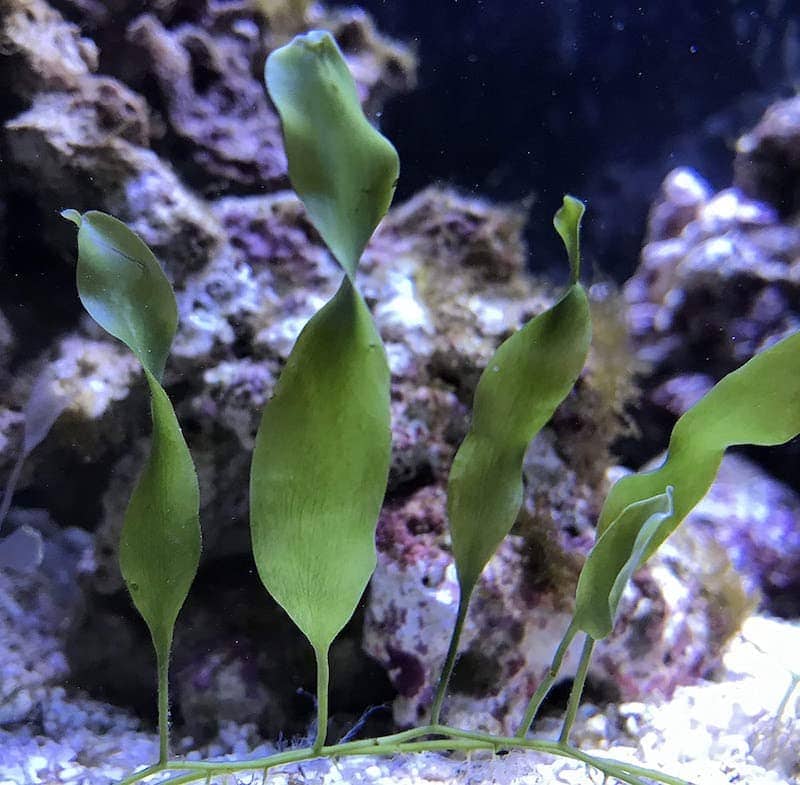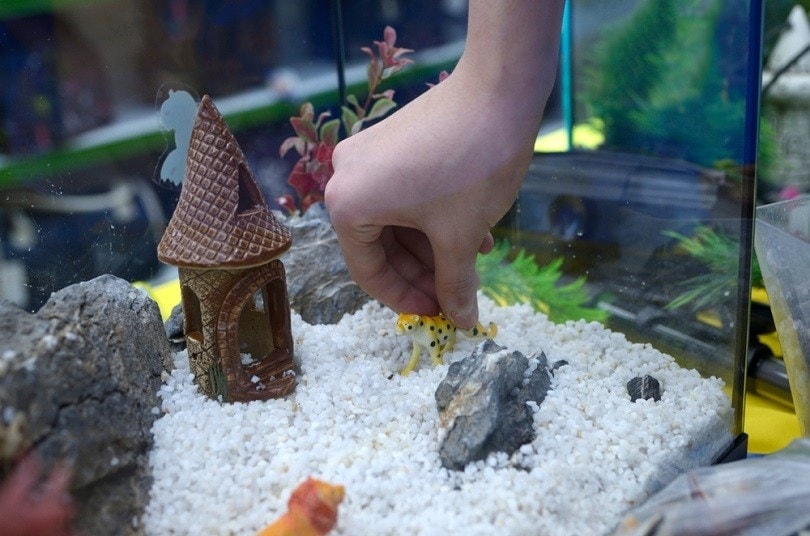Clown Loach: Vet-Approved Pictures, Size, Care, Tank Setup, & More
Updated on
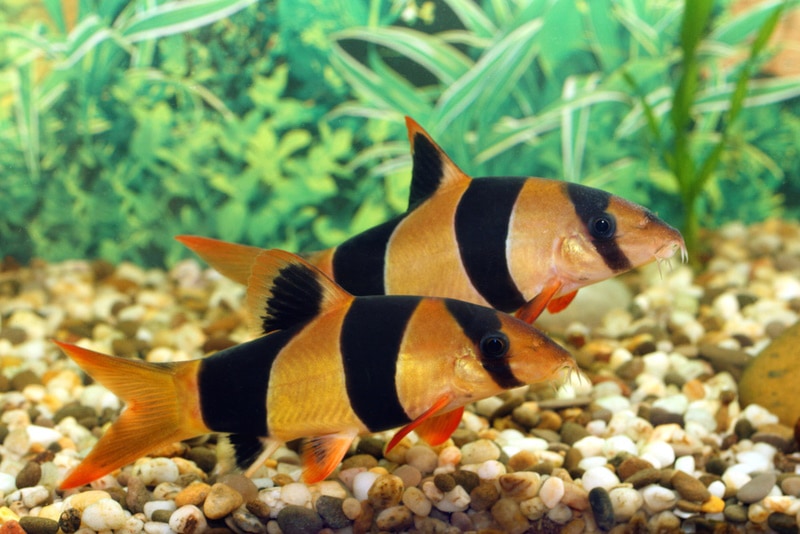
Click to Skip Ahead
Clown loaches (Chromobotia macracanthus) are large freshwater fish that make great pets for more experienced fish keepers. Clown loaches are known to reach up to 8 inches in captivity and require very large aquariums. They are highly social and have specific care requirements that need to be met if you want them to thrive in captivity. Despite their moderate care level, clown loaches are ideal for fish keepers who want playful schooling fish that are active and spend most of their time foraging for food.
Raising a group of clown loaches is a rewarding experience, and with proper care, they can live for up to 10 years, with some unverified anecdotal claims saying that they may live up to 30 years.
Quick Facts About Clown Loaches
| Species Name: | Chromobotia macracanthus |
| Family: | Botiidae |
| Care Level: | Moderate |
| Temperature: | 24–30°C (75.2–86°F) |
| Temperament: | Social and active, able to make “clicking” sounds |
| Color Form: | Orange body, red fins, and black stripes |
| Lifespan: | 10 to 12 years (estimate) |
| Size: | Up to 8 inches (20 cm) on average |
| Diet: | Omnivore |
| Minimum Tank Size: | 150 gallons for a group of 5 |
| Tank Set-Up: | Spacious, heated, freshwater tanks |
| Compatibility: | Shoaling fish |
Clown Loach Overview
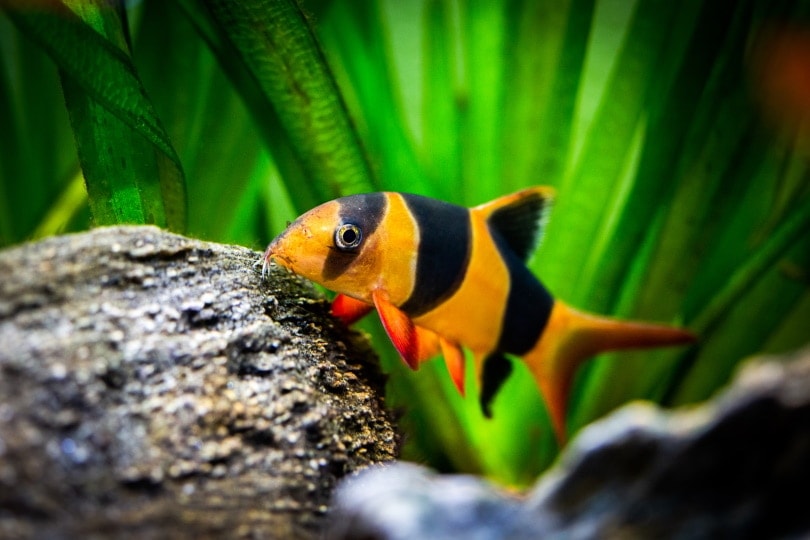
The clown loach was first described in 1852 by Pieter Bleeker and scientifically classed as Cobitis macracanthus. Later in 1989, their name was changed to Botia macracanthus. Now, the clown loach is scientifically known as Chromobotia macracanthus since they were placed into the Chromobotia genus in 2004. They belong to the Botiidae loach family, which contains over 50 different species of ray-finned fish from Asia.
Clown loaches originate from southeast Asia, Indonesia, where they inhabit the tropical waters in the inland waters of the Borneo and Sumatra islands. They get their name from their bright orange and red coloration with thick black banding on their bodies. However, they are sometimes referred to as tiger botia. All clown loaches are freshwater fish that prefer warm water both in the wild and as pets. Their wild freshwater habitats consist of warm, clear streams that experience biannual flooding. Most wild clown loaches will live in flooded plains or blackwater rivers for a portion of the year. In the wild, clown loaches prefer a water temperature of around 25°C to 30°C (77°F to 86°F).
Clown loaches have made their way into the pet trade industry and are now kept as aquarium pets around the world. Many fish keepers find the clown loaches’ temperament and appearance appealing, and they are generally fun to care for. However, their living conditions and specific water requirements make them a better choice for intermediate or experienced fish keepers.
How Much Do Clown Loaches Cost?
Clown loaches aren’t considered to be expensive fish. You can expect to pay between $5 and $10 for one. But since they are a social species and thrive in groups, you will need to adopt at least five of these fish. This will bring the average cost for a group of five clown loaches to around $25 to $50 from pet stores.
Typical Behavior & Temperament
The clown loach is an active and highly social species of fish. They enjoy being kept in groups of five or more to form a small shoal, and this will bring out their playful and interactive behavior. If you keep clown loaches alone or in pairs, you will find that they become stressed more easily and might prefer to hide in an aquarium. This added stress weakens their immune system, making them more susceptible to diseases.
If the aquarium is large enough, a group of six to eight clown loaches will be ideal. During the day, clown loaches will actively forage for food and interact with each other. They prefer to spend most of their time swimming along the bottom of the aquarium where they forage among the substrate for food. While it is not uncommon for clown loaches to be on the shy side, they usually don’t hide much when their conditions are ideal.
Clown loaches are known to “play dead” at times, a phenomenon that can catch first-time owners by surprise. The reasoning for this behavior isn’t completely understood, and it’s best not to jump to conclusions if your loaches appear lifeless.
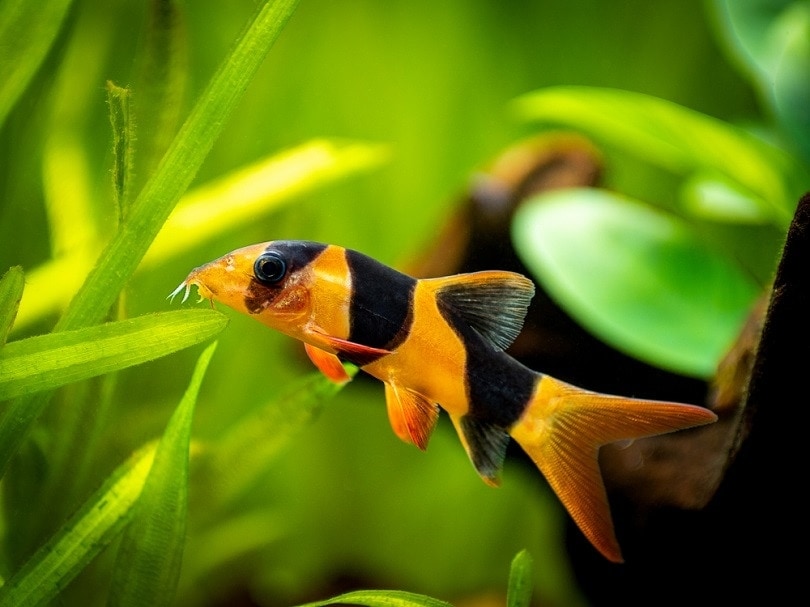
Appearance & Varieties
Clown loaches grow quite large in captivity, reaching an adult size of around 8 inches. However, some anecdotal estimates postulate a length of around 12 inches (for fully mature adults). It can take 1–2 years for clown loaches to reach this size, and their living conditions and diet play a role in their growth and development as juveniles. Most pet stores sell clown loaches when they are still small at only 3 to 5 inches, so many fish keepers are often overwhelmed with just how big they can grow.
In terms of appearance, the clown loach has short and angular fins. They have a split caudal fin that has a reddish-orange coloration. Their body is a yellowish-orange color with thick, triangular bands starting from the base of their tail fin to their head. They have two small eyes on either side of their head, and they have four pairs of short barbels around their downturned mouths.
Both male and female clown loaches look similar, though the tip of the caudal fin turns inward in males. The male’s caudal fin is usually larger and more brightly colored than the female’s. Also, the female has a slightly shorter tail with a more rounded body. Otherwise, there is not much variation in clown loaches, and they all have the standard orange, red, and black stripe color pattern.
How to Take Care of Clown Loaches
Habitat, Tank Conditions & Setup
Tank Size
Since clown loaches can grow very big and need to live in groups, their tank needs to be quite large. The minimum tank size for one clown loach is around 30 gallons. For a small group of three to five clown loaches, their minimum tank size is between 100 and 150 gallons. The more clown loaches you keep in an aquarium, the larger it needs to be. You will need to ensure that you can provide your clown loaches with at least 150 gallons of space, and they should not be kept alone in small tanks or in numbers smaller than a shoal of five.

Water Quality & Conditions
Clown loaches require good water quality to stay healthy. They are freshwater fish that do not tolerate salt in their environment, and their tank needs an aquarium heater. To ensure that the water quality is suitable for clown loaches, their tank should be cycled and show no traces of ammonia or nitrite from a water testing kit.
- Temperature: 24–30°C (75.2–86°F)
- pH: 6-8
- Hardness: 5 to 15 dH
Substrate
As bottom-dwelling fish, clown loaches will spend most of their time on the substrate. You want to choose a substrate that doesn’t have any sharp edges that could injure their bodies. A sandy or round pebble-like substrate is usually recommended for clown loaches. They are particularly fond of sandy substrate because they enjoy sifting through it with their barbels.
Plants
Clown loaches can benefit from live plants in their aquarium, but fake ones are an option too. They may occasionally uproot plants while they forage, so you might find that weighing the plants down in the substrate can prevent this.
Lighting
Bright lights aren’t recommended for clown loaches, and they prefer a more low or moderately bright aquarium light. The lights should only be on during the day and turned off at night. Avoid keeping them on for more than 12 hours at a time to prevent algae blooms. If you have live plants in your aquarium, your lighting should cater to the needs of the plants.
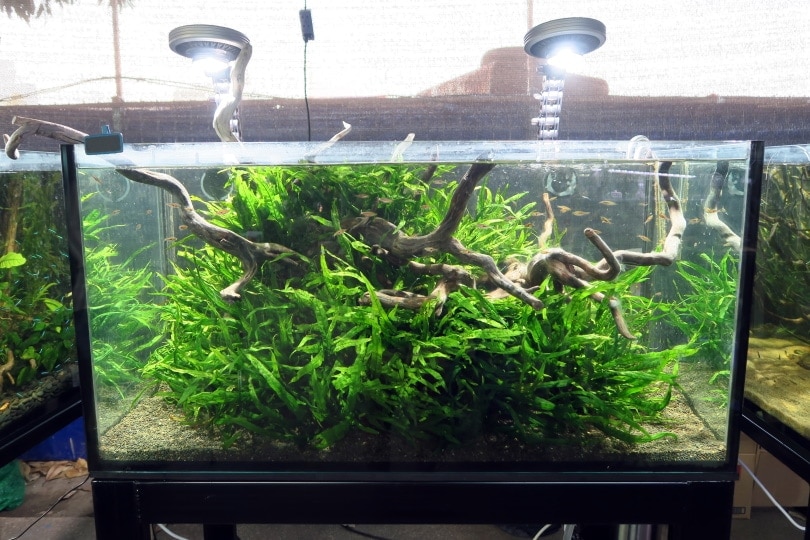
Filtration
Your clown loach aquarium should contain a filter that is appropriate for the size of the tank. The filter will keep the water moving and process the waste from your fish. Clown loaches aren’t fond of strong currents in the water, so choose one that does not produce this. You can choose from a sponge, hang-on-back (HOB), and cartridge filters for your fish.
Are Clown Loach Good Tank Mates?
Clown loaches are not aggressive or territorial, so they can be kept in community aquariums. However, due to their peaceful temperament, you should only keep clown loaches with other peaceful fish that require similar water conditions. The best tank mates for them are their species. They are highly social fish that form shoals and benefit from being kept in both small and large groups. You can keep other fish with clown loaches if the tank is large enough to support all the inhabitants.
Suitable Tank Mates:
- Tiger barbs (Puntius tetrazona)
- Angelfish (Pterophyllum)
- Clown pleco (Panaque maccus)
- Rosy barbs (Puntius conchonius)
- Neon dwarf rainbowfish (Melanotaenia praecox)
- Australian pearl arowana (Scleropages formosus)
- Discus (Symphysodon aequifasciatus)
Please note that all these fish are compatible with each other (and with clown loaches). Also, a community aquarium with these fish will require a very large aquarium.
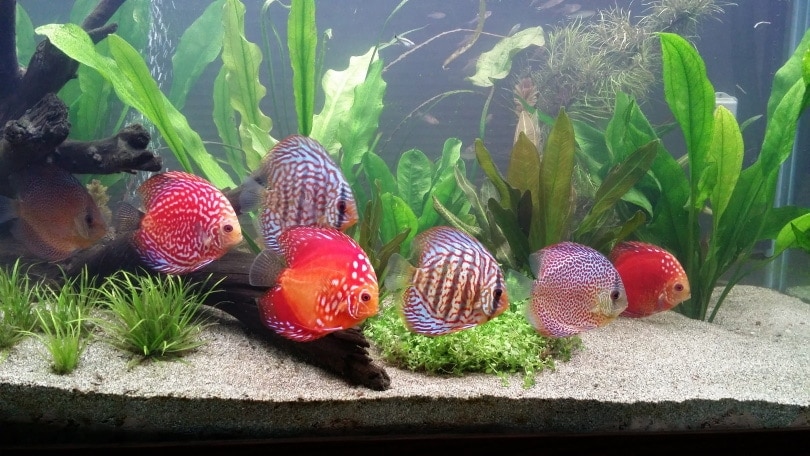
What to Feed Your Clown Loach
The clown loach is an omnivore. They naturally eat small crustaceans, vegetation, worms, and insects in the wild. They are an opportunistic feeder and as pets, will accept most foods. A clown loach’s diet should ideally consist of sinking pellets, live or frozen foods, and supplements.
A high-quality sinking pellet formulated for bottom feeders like clown loaches should be their staple food. You can offer live or frozen foods like bloodworms, brine shrimp, and daphnia to them a few times a week. Clown loaches also benefit from being fed the occasional algae wafer, spirulina, and blanched veggies.
Keeping Your Clown Loach Healthy
It is relatively easy to care for your clown loach and keep them healthy. Here are several tips you can use to keep your clown loaches healthy.
- Keep your clown loaches in a spacious tank with a rectangular shape. Clown loaches require a lot of space at the bottom of the tank versus tall tanks. They do most of their swimming and activities along the tank’s substrate. You want to ensure that the tank is large enough to support the number of clown loaches you keep, which is usually over 150 gallons in size.
- The water should be heated to a comfortable temperature with few fluctuations. Regular water changes can help dilute pollutants in the water and replenish it with fresh water.
- Your clown loach tank should be filtered to prevent the water from becoming stagnant and the waste from dirtying the tank.
- Lastly, clown loaches should be fed healthy and balanced food, usually once or twice a day. Juveniles may need to be fed more often.
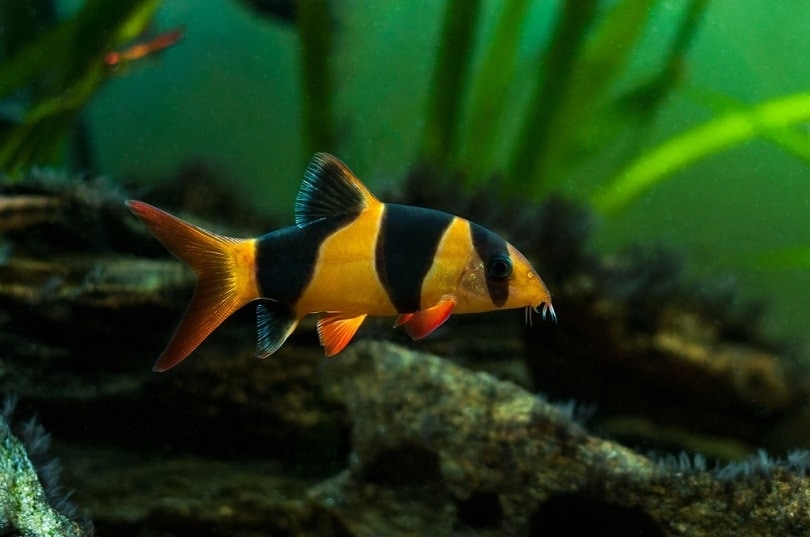
Breeding
Breeding clown loaches is challenging in an aquarium. It requires certain expertise and skills, which is why almost all clown loaches kept as pets are bred in select centers in two locations: Indonesia and Europe. The space requirement for breeding this fish is massive, and they also have specific hormonal requirements to spawn. Spawning them as pets is not recommended.
Conclusion
Clown loaches can be fascinating additions to large freshwater aquariums. Since clown loaches can grow to around 8 inches in size, they require very big tanks of over 150 gallons. They require ample space to form shoals with other clown loaches and swim comfortably. As a social species, they should not be kept alone or in pairs. It is best to keep them in groups of five or more to encourage their social behaviors.
If your aquarium is not large enough to support their adult sizes and groups, clown loaches won’t be a good choice for your aquarium. Although they can be great additions to community aquariums, they shouldn’t be kept with aggressive, small, or cold-water fish.
Besides a spacious tank and balanced diet, clown loaches require specific water conditions to stay healthy. They can be at risk of developing an illness if they are kept in cold or dirty environments, making them a poor choice for aquariums that experience temperature fluctuations or have very hard water.
With proper care and ideal living conditions, clown loaches can live for over 10 years.
Featured Image Credit: Grigorii Pisotsckii, Shutterstock




